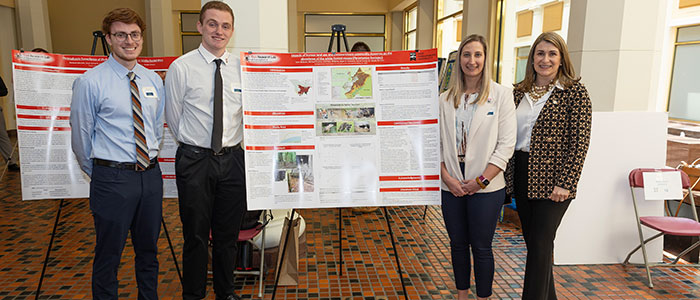ESU Students Present Research at Capitol in Harrisburg

Posted by: Elizabeth Richardson on March 20, 2024, No Comments
Photo: East Stroudsburg University students, Nicholas Mazzella and Tavin Rickoski, are joined by Nicole Chinnici, DHS, director of ESU’s Dr. Jane Huffman Wildlife Genetics Institute, and Pennsylvania State Senator Rosemary Brown during a presentation at the Capitol in Harrisburg on Tuesday, March 19.
Two East Stroudsburg University students participated in Undergraduate Research at the Capitol – Pennsylvania on Tuesday, March 19.
Nicholas Mazzella, a senior majoring in biology from Bangor, Pa. presented a poster on their research “Pennsylvania Surveillance of Ehrlichia Muris Eauclairensis in White-Footed Mice.” Ehrlichia muris eauclairensis (EME) is a bacterium which causes human Ehrlichiosis, which is an infection of the white blood cells. The black-legged tick (Ixodes scapularis) is the only competent vector which can transmit EME to both humans and animals following exposure through a tick bite. The distribution of human Ehrlichiosis cases is established in the central and southern regions of the United States. However, a recent study done at the University of Massachusetts-Amherst detected EME in tick and mice populations for the first time in the Northeast. There are no cases of EME that have been found in Pennsylvania wildlife. This project aims to do surveillance of EME across Pennsylvania. From the summer of 2023, through active surveillance, blood was collected from white-footed mice (Peromyscus leucopus) at thirteen sites, covering both eastern and western parts of the state. A total of 695 mice were screened for EME using an optimized qPCR assay. Regional surveillance of reservoir populations is essential in monitoring the local emergence of tick-borne pathogens.
Tavin Rickoski, senior majoring in biology from Tatamy, Pa. presented a poster on their research “Impacts of human land use and mesocarnivore community dynamics on the abundance of the white-footed mouse (Peromyscus leucopus)”. Peromyscus leucopus has been well documented as the primary reservoir for Borrelia burgdorferi, the causative agent for Lyme disease. Previous studies found that mesocarnivores may have significant effects on the abundance of P. leucopus. The research investigated these relationships in northeastern Pennsylvania. An active surveillance study included 18 sites classified as either residential, park or school sites, based on human land use in the area, and camera traps were used to obtain data on the presence of certain species at that site. Capture-mark-recapture was used to obtain estimations of P. leucopus abundances at each site. Statistical analyses were used to determine relations between site type, presence, and absence of mesocarnivore species, and quantity of other small mammal species on P. leucopus abundance. Data indicated that in parks and residential areas the number of mesocarnivore species present can act as a predictor of P. leucopus abundance. Our data also indicated that red foxes (Vulpes vulpes) have a greater effect on P. leucopus abundance than any other mesocarnivore species. Future studies into this topic should focus on the effect of red foxes and how human impacts shape these dynamics.
Undergraduate Research at the Capitol – Pennsylvania is a poster conference that showcases outstanding and award-winning research projects by undergraduate students from Pennsylvania. The event provides an opportunity for students, faculty, and Pennsylvania legislators and staff to share the experiences of student engaged research in scholarship at their colleges and universities.




